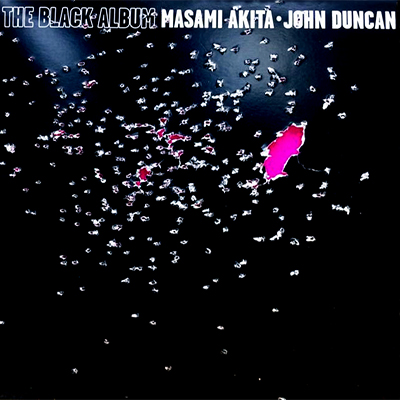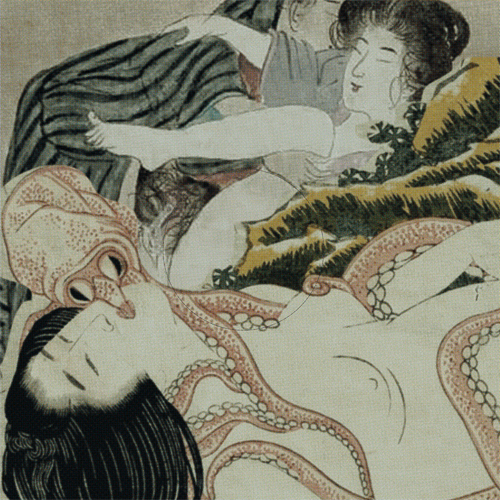The BLACK ALBUM
2014John Duncan and Masami Akita
Tourette 040
Green vinyl LP in hot pink sleeve with black cover perforated by a shotgun blast
Released by Tourette.
Download available on Bandcamp
The first thing that greets the listener upon receiving Akita and Duncan's collaborative Black Album is the fragility of its packaging: gutted by a shotgun blast, the wounds in the plain black cover reveal a lurid, high-gloss pink inner sleeve which provides the last line of defense for the record itself. A preliminary visual statement of this kind braces the listener for the kind of Zen epiphany that occurs when being whacked with the stick of the rōshi. But, with that in mind, I should offer up a disclaimer: this record should not be listened to as an explosive kind of "supergroup" meeting of the minds; as one of those watershed artefacts in which an unanticipated fusion of different approaches births a whole new attitude towards personal expression. It is a "conversational" collaboration seemingly guided by no single principle, which John's own introductory text seems to make clear:
Masami's and my conversations look like heroin addicts talking:
A phrase.
A five minute silence.
Another phrase.
A five minute silence.
A question.
A five minute silence.
Another phrase.
A five minute silence.
An answer.
Et cetera.
The BLACK ALBUM shows what's going on in our heads.
A disc of actual verbal conversations along the lines mentioned above would itself be a worthy exchange for money - both these individuals are highly fluid communicators; Masami Akita in particular has a keen understanding of linguistics, and the cold grimness that music critics like to project onto him belies his genuine sense of humor. However, the sonic content of The Black Album consists instead of non-verbal soundmarks that will initially be identified with each of the artists, and which will eventually merge into a single current.
A frantic, percolating kind of audio synthesis dominates the A-side, seemingly bent on preventing the listener from discovering secrets contained in the layers of atmospheric sound just beneath. Of course, the longer this agitated, electrified dance is allowed to continue, the more this yawning backrop becomes an object of consuming curiosity. The one clue as to "source material" that Duncan provides us - that recordings were made in the Gran Sasso nuclear laboratory - is enough to make us want to know what this subdued mechanical roar is all about, and what implications (catastrophic or otherwise) it might have for us if we get closer to it. Just when it seems we are getting closer to finding on what goes on behind the curtain, though, a series of massive waves come crashing down to close out the first side, leaving any questions unresolved. The untitled B-side of the record leaves listeners with even fewer easy reference points, throwing them into an inner space where metal ribbons rain and, again, vie for attention with the plaintive song of undefined power sources. This time around, the journey ends with an abrupt silence rather than a wash-out.
It should come as little surprise that this is a noisy work - often reaching that threshold point in which the recording instruments seem to be gasping for air - but it's a noise that is satisfyingly removed from the kind of material that would actually take pride in being called "noise." Namely, this record steers well clear of the bells-and-whistles approach that brings this supposed anti-genre a little closer to the showbiz culture it supposedly abhors. It wisely cleaves to an artistic vision of saturated sound as a force that is already undergoing a number of permutations in the listener's mind, well before a multitude of effects boxes and custom patches are brought to bear on it. Akita and Duncan continue their work here as emissaries of the elemental, in all its perplexing majesty.
-- Thomas Bey William Bailey
More reviews

YEAH
2014John Duncan and Jim O'Rourke
iDEAL117
Black vinyl LP released by iDEAL.
Side A: recorded and mixed in 1993 by John Duncan and Jim O'Rourke at Christoph Heemann's studio in Aachen. Final mix by Jim O'Rourke in Tokyo.
Side B: STAY ALIVE recorded live with Oren Ambarchi and Joe Talia on 9 March 2013 at SuperDeluxe, Tokyo; mixed by Joe Talia.
The inevitably momentous wholeness constitutes a high point in both artists' discographies, sounding as modern as yesterday. Friendly advice: let this piece resonate loudly from the speakers.
If the first half symbolizes a journey through the darkest aspects of the subconscious, "Stay Alive" is an out-and-out cathartic ritual. The incitement is barely whispered at the outset; then, as Talia and Ambarchi increase their contribution via metaphysical sonorities and irregular drumming, the man from Wichita enters a condition of preternatural despair. The progressively louder screaming literally strips him of his normal vocal tone, gradually replaced by a hoarsely yelping reiteration. In the concluding instants after the burnout, near-inaudible instrumental touches escort us to silence. A parallel with Duncan's earlier experiments with Reichian hyperventilation applies, as far as balance between anguished transmittance and individual purification is concerned.
-- Massimo Ricci, Touching Extremes
More reviews
